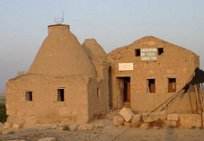 Harran is an ancient city in the Upper Mesopotamia, dating back to the Early Bronze Age in the 3rd millennium BC. Harran was established as a merchant outpost as it was situated along a trade route between the Mediterranean and the plains of Tigris river. Today it's located near the modern village of Altinbasak, about 45 kilometers (28 miles) south of Sanliurfa city in the Southeastern Anatolia, in Turkey.
Harran is an ancient city in the Upper Mesopotamia, dating back to the Early Bronze Age in the 3rd millennium BC. Harran was established as a merchant outpost as it was situated along a trade route between the Mediterranean and the plains of Tigris river. Today it's located near the modern village of Altinbasak, about 45 kilometers (28 miles) south of Sanliurfa city in the Southeastern Anatolia, in Turkey.
In Harran the landscape flattens into the Mesopotamian plain, broken only by the ancient mounds and obscure, mud brick villages. Here lies a part of Turkey experiencing extremely rapid change, especially as it was formerly one of the poorest and least developed areas in the country until few decades ago.
Some 15 kilometers (9 miles) off the main tarmac road leading to Syria, turn left and ask for Sultantepe, apparently a major site in ancient Carrhae, where tablets inscribed with the legends of Gilgameth (Gilgamis) have been unearthed. Farther down the dirt road are the ruins of Sumurtar, a large mound with a labyrinth of passages and underground chambers used by the Sabians, worshippers of the sun, moon and planets. The grottos were clearly used for ceremonial purposes; some seem to have been later converted into subterranean mosques replete with mihrab facing the direction of Mecca.
Back toward the main road is the village of Harran itself, with its beehive-like dwellings. It was a major commercial, cultural, and religious center. Here was the site of the Temple of Sin (known also as the first university), famous throughout the ancient world for its star readers and savants. It was in Harran where Rebecca drew water for Jacob, from whence Abraham decided to make his move into the land of Canaan. This was also where the Roman Emperor Crassus was defeated by the Parthians, with the Legion standards captured and brought back to Ctesiphon to the undying shame of the Romans; Crassus himself reportedly died by having liquid gold poured down his mouth. Later, the Emperor Julian the Apostate worshipped the moon here on the way to his fateful encounter with Shapur I farther east. Harran was also the last hold out of the Sabians, the pagans who had managed to survive through to the 11th century. Standing atop the ruins of the ancient citadel, one overlooks the scattered bits of rock and material - history stretching back to the very dawn of time: the very potsherds crunching underfoot have an immediacy here, the broken vessels having surely been used by some long forgotten ancestor from the land of Ur, an acquaintance of Abraham, or a Roman legionnaire from Gaul, whose memory now swirls with the dust devils across the oblate horizon.

